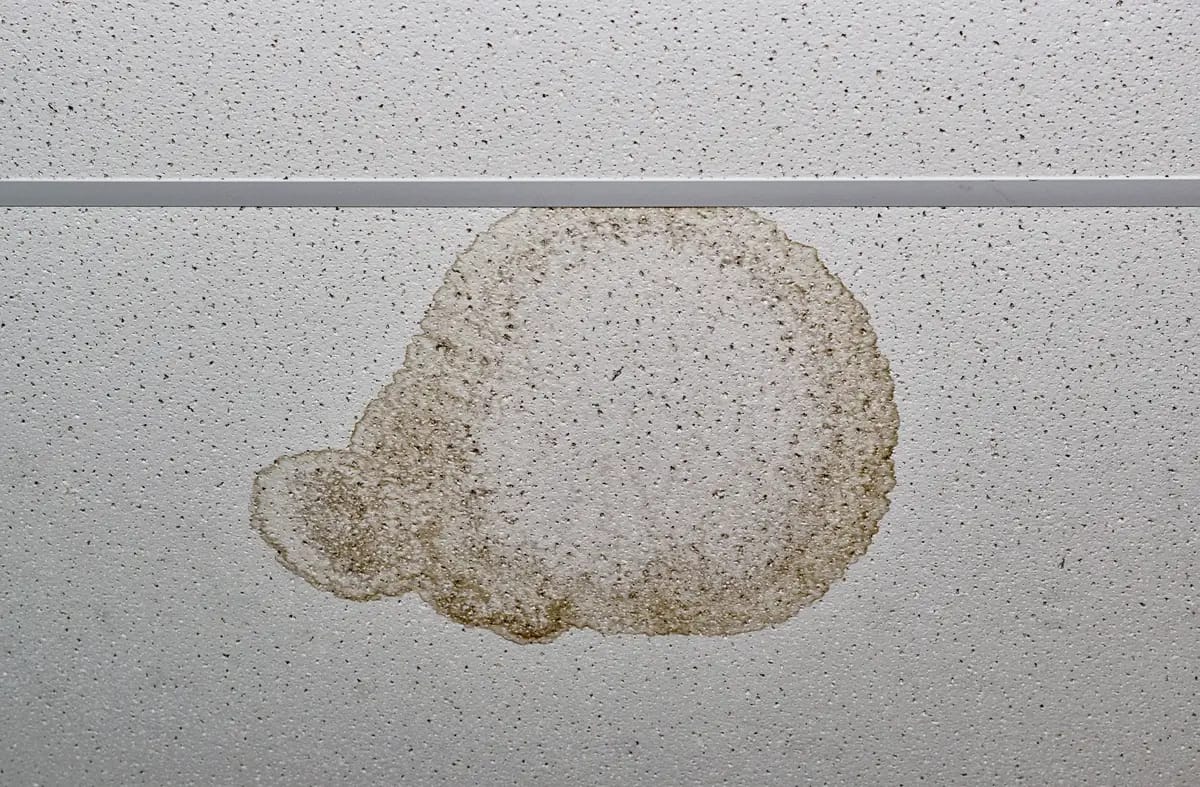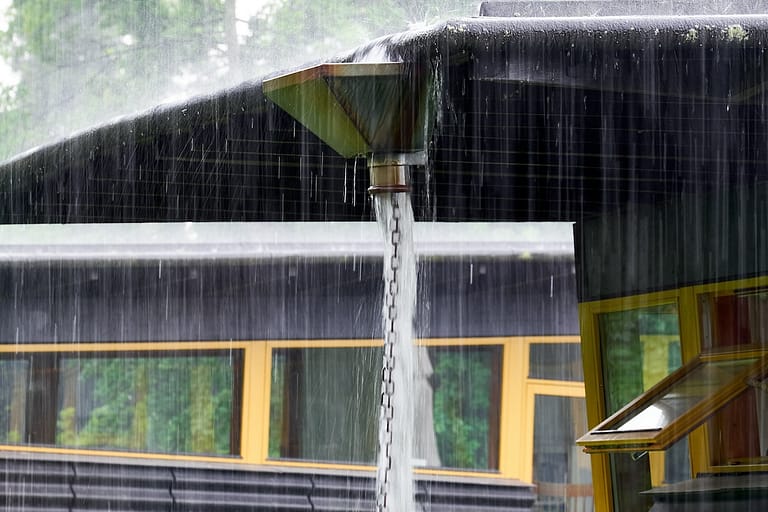Roof leaks in commercial properties can quickly escalate from minor nuisances to major structural issues, causing significant damage and costly repairs. For commercial property owners, understanding the intricacies of commercial roof leak repair is crucial in maintaining the integrity and safety of their buildings.
Today’s thorough guide will walk you through:
- The essential steps to identify a commercial roof leak
- How to address it
- Tips to prevent commercial roof leaks effectively
Common Types of Commercial Roofs
So, what makes a commercial roof different than a residential one? For most buildings, it comes down to design. Here are a few different types of commercial roofs.
Flat Roofs
Flat roofs are a common choice for commercial buildings due to their cost-effectiveness and ease of maintenance. However, they are prone to specific issues:
- Ponding Water: Poor drainage can lead to water accumulation, causing leaks and structural damage.
- Membrane Damage: The roofing membrane, typically made of materials like EPDM, TPO, or PVC, can develop punctures and tears.
- Seam Failures: Improperly sealed seams can allow water to penetrate.
Metal Roofs
Metal roofs are durable and long-lasting but can develop leaks due to:
- Corrosion: Rust and corrosion weaken metal panels and joints over time.
- Loose Fasteners: Expansion and contraction of metal can cause fasteners to loosen.
- Flashing Issues: Damaged or improperly installed flashing can lead to leaks.
Shingle Roofs
Shingle roofs, commonly used on smaller commercial properties, have their own set of challenges:
- Damaged Shingles: Cracked or missing shingles create entry points for water.
- Granule Loss: Worn-out shingles lose protective granules, reducing their effectiveness.
- Valley Leaks: Valleys, where two roof planes meet, are prone to water infiltration.
Understanding Commercial Roof Leaks
Commercial roof leaks can result from various factors, including:
- Age and Wear: Over time, roofing materials deteriorate due to constant exposure to the elements.
- Poor Installation: Faulty installation can compromise the roof’s integrity right from the start.
- Weather Conditions: Extreme weather, such as heavy rain, snow, hail, and strong winds, can cause damage to the roof.
- Lack of Maintenance: Neglecting regular maintenance can lead to unnoticed damage and leaks.
- Debris Accumulation: Leaves, branches, and other debris can clog gutters and drains, causing water to back up and seep into the roof.
- Mechanical Damage: Foot traffic, HVAC units, and other rooftop equipment can cause physical damage to the roofing materials.
Signs of Roof Leaks
Early detection of roof leaks can save you time and money. Look for these common signs:
- Water Stains: Discolored patches on ceilings or walls are indicators of water infiltration.
- Mold Growth: Damp conditions from leaks can lead to mold growth, posing health risks.
- Dripping Water: Obvious water drips during rainstorms are a clear sign of a leak.
- Musty Odors: Persistent musty smells can indicate hidden water damage.
- Puddles on the Roof: Pooling water on the roof surface may signify drainage issues.
Steps to Identify Roof Leaks
Visual Inspection
A thorough visual inspection is the first step in identifying roof leaks. Here’s what to look for:
🏠 Exterior Inspection:
Check for visible damage such as cracks, blisters, and punctures. Inspect flashing around roof penetrations, such as vents, chimneys, and skylights.
You’ll also want to examine gutters and downspouts for blockages and signs of rust or damage. Look for loose or missing shingles, tiles, or panels.
🚪 Interior Inspection:
Take the time to examine the ceiling and walls for water stains or discoloration. Check for mold growth or musty odors, especially in corners and low-traffic areas.
Be sure to also inspect attic spaces for dampness, mold, or structural damage.
Water Testing
If visual inspection doesn’t reveal the leak’s source, water testing can help pinpoint the problem. Follow these steps:
💧 Controlled Water Application:
Use a garden hose to apply water to specific sections of the roof. Start from the lowest point and work your way up, focusing on suspect areas.
🔎 Monitor Interior:
Have someone inside the building observe for water infiltration while another person applies water outside. Note the location and timing of any leaks that occur during testing.
Temporary Roof Repairs
Temporary repairs can provide immediate relief until permanent solutions are implemented. Here are some quick fixes:
- Patching: Apply roofing cement or patches to seal small cracks and holes.
- Tarping: Cover larger areas with waterproof tarps to prevent further water ingress.
- Sealant Application: Use silicone or polyurethane sealants to seal leaks around flashing and roof penetrations.
Permanent Repairs for Commercial Roofs: 6 Steps
For long-term solutions, consider the following permanent repair methods:
1) Patching Membrane:
Clean the damaged area thoroughly, then cut a patch from the same material as the roofing membrane. Apply roofing adhesive to both the patch and the damaged area. Press the patch firmly onto the damaged area and smooth out any air bubbles. Seal the edges of the patch with roofing tape or adhesive.
2) Reinforcing Seams:
Clean the seam area to remove dirt and debris. Apply seam tape or adhesive along the seam. Press the seam firmly and remove any excess tape or adhesive.
3) Replacing Corroded Panels:
Metal roofing and flashing is sometimes susceptible to corrosion. In order to fix this, remove the damaged panel by unscrewing or cutting it out. Install a new panel of the same material and size. Secure the new panel with screws or fasteners.
4) Repairing Flashing:
Remove the old flashing and clean the area. Cut new flashing to fit and secure it with roofing nails or screws. Apply a sealant to ensure watertightness.
5) Replacing Damaged Shingles:
If your commercial roof has shingles, it is important to replace any damaged ones promptly. Remove the damaged shingle by lifting the edges and pulling out the nails. Slide a new shingle into place and nail it down. Apply roofing cement to the edges of the new shingle for added security.
6) Sealing Valleys:
Clean the valley area and remove debris. Apply a layer of roofing cement along the valley. Place a strip of roofing membrane over the cement and press it down.
Preventing Future Roof Leaks
You can get ahead of your roof leaks, by taking these prevention measures.
Regular Maintenance
Consistent maintenance is key to preventing future leaks. Implement the following practices:
- Scheduled Inspections: Conduct bi-annual inspections, ideally in spring and fall, to identify potential issues early.
- Gutter Cleaning: Keep gutters and downspouts clear of debris to ensure proper drainage.
- Trim Overhanging Trees: Prevent branches from damaging the roof or clogging gutters.
- Roof Cleaning: Remove dirt, algae, and moss that can degrade roofing materials.
Professional Assessments
Reach out to professional roofing contractors for comprehensive assessments and maintenance:
- Roofing Audits: Hire experts to conduct thorough roof audits, identifying vulnerabilities and recommending repairs.
- Preventive Maintenance Programs: Enroll in preventive maintenance programs offered by roofing companies to ensure regular upkeep.
Upgrading Roofing Materials
Consider upgrading your roofing materials to enhance durability and leak resistance:
- High-Quality Membranes: Invest in premium roofing membranes with superior puncture resistance and longevity.
- Impact-Resistant Shingles: Choose shingles designed to withstand severe weather conditions.
- Rust-Resistant Metal Coatings: Opt for metal panels with protective coatings that prevent corrosion.
When to Consider Roof Replacement
Suspect a roof replacement is in your future? Look for the following:
Signs It’s Time to Replace Your Roof
While repairs can address many issues, there comes a point when roof replacement becomes necessary. Look for these signs:
- Extensive Damage: Multiple leaks, widespread damage, and recurring issues indicate the need for replacement.
- Aging Roof: If your roof is nearing the end of its lifespan (typically 20-30 years), replacement is a wise investment.
- Rising Repair Costs: Frequent repairs and escalating costs suggest it’s more economical to replace the roof.
Benefits of Roof Replacement
Replacing your commercial roof offers several advantages:
- Enhanced Durability: New roofing materials provide better protection against leaks, weather, and wear.
- Improved Energy Efficiency: Modern roofing systems offer better insulation, reducing energy costs.
- Increased Property Value: A new roof enhances the overall value and appeal of your commercial property.
Choosing the Right Roofing Contractor
Selecting a reputable and experienced roofing contractor is crucial for successful roof repairs or replacement. Consider these qualities:
- Licensing and Insurance: Ensure the contractor is licensed and carries adequate insurance coverage.
- Experience and Expertise: Look for contractors with a proven track record in commercial roofing.
- References and Reviews: Check customer reviews and ask for references to gauge the contractor’s reliability.
When interviewing potential roofing contractors, ask the following questions:
- What type of roofing materials and systems do you specialize in?
- Can you provide a detailed estimate and timeline for the project?
- Do you offer warranties for your work and materials?
- How do you handle unexpected issues or changes during the project?
We’ll Take Care of Your Leaking Roof
Commercial roof leaks can disrupt your business operations and lead to costly damages if not addressed promptly.
Don’t wait for leaks to become major problems—take action today to safeguard your commercial property. If you need expert assistance or have any questions, feel free to reach out to our team at G. Cannon. We’re here to help you keep your roofs leak-free and your business thriving.








